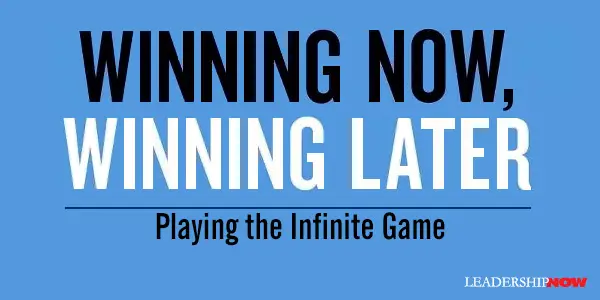 |
 |
06.22.20

Winning Now, Winning Later: Playing the Infinite Game
WHEN David Cote became CEO of Honeywell in February of 2002, the company was a train wreck. He inherited unhealthy accounting practices, unresolved environmental liabilities, and a board and staff that were denying reality. Cote shares in Winning Now, Winning Later, a practical example of playing the infinite game. When he took over, Honeywell was plagued by short-termism. The problem was that he had to deliver something in the short-term to the investors for survival but had to set the company up for tomorrow too. He did both. I realized we could do both at the same time. Short- and long-term goals were more tightly intertwined than they appeared. By taking the right actions to improve operations now, we could position ourselves to improve performance later, while the reverse would also hold true: short-term results would validate that we were on the right long-term path. He developed three principles of short- and long -term performance that forced them to consider the long- and short-term implication in every decision they made: 1. Scrub accounting and business practices down to what is real.
The process begins by defining reality and banishing intellectual laziness. Short-term thinking is often one dimensional—what it takes to meet the expectations of the current quarter without concern for the consequences. What is needed is drilling down to root causes and finding new and creative solutions. This means eradicating the quick fixes that “keep people stubbornly focused on today at tomorrow’s expense.” The quality of thought in a team or organization matters. If you want a business that performs both today and tomorrow, you need to take apart your business and put it back together again so that it works more efficiently and effectively. This means instilling an intellectual mindset, spurring your people to think harder about every business decision they face. Set the standard for intellectual engagement. Demand that your people pursue two seemingly conflicting things at the same time. Make it your mission to understand the nuances of your business so that you can shape and guide your teams’ intellectual inquiry. Making decisions for both short- and long-term performance isn’t something that you learn to do all a once. It is a process. It requires a “period of up-from investment, during which performance might lag for a little while. As a leader, you have to suck it up and make sure your investments pay off.” Cote offers example after example of what this looks like in terms of changing the culture of the company and the thinking developed as people worked through issues and broke down processes to find the previously undiscovered efficiencies within. At the end of the book, he leaves us with some sound advice. He shares his self-defeating behavior early in life that led him nowhere and the commitment that was required to turn his life around. As we’ve seen, winning today and tomorrow requires extraordinary effort and commitment on the part of leaders, teams, and organizations. I share my life story of how I got my life together to illustrate a simple but underappreciated fact: individuals and groups can push themselves much further than they think. So many teams and organizations produce disappointing short- or long-term results because they don’t know how to operate differently than they have, but also because they don’t think they can operate differently. You have it in you as a leader to push your people to do two seemingly conflicting things at the same time, and your people have it in them to deliver, so long as you provide diligent encouragement, guidance, and oversight along the way, while also making sure you have the right people in the right positions. When providing guidance, tr to do more than just saying, “Do better.” Provide some thought starters or suggestions that can mobilize your people to think differently about the issue at hand. The resistance to the winning now, winning later mindset often comes from the leadership and not the frontline staff because they live the consequences of short-term think every day. Final advice: Create the virtuous cycle in which you generate short-term actions sufficient to satisfy investors while still supporting long-term investments. If you do, you’ll find that over time the short-term results will begin to take care of themselves. By implementing this thinking at Honeywell, under Cote’s leadership, market cap grew from $20 to $120billion, cleaned up legacy environmental issues, and created 2,500 401K millionaires because employees had invested in the company, 95% of them below the executive level. 
Posted by Michael McKinney at 05:36 PM
|
BUILD YOUR KNOWLEDGE
 

How to Do Your Start-Up Right STRAIGHT TALK FOR START-UPS 
Grow Your Leadership Skills NEW AND UPCOMING LEADERSHIP BOOKS 
Leadership Minute BITE-SIZE CONCEPTS YOU CAN CHEW ON 
Classic Leadership Books BOOKS TO READ BEFORE YOU LEAD |